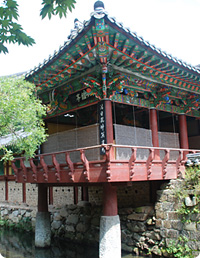PACKAGE
Andong / Songnisan 6 days
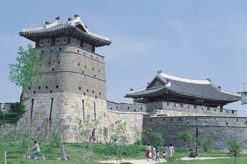
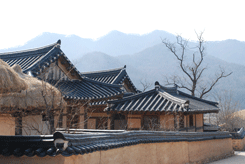
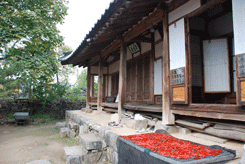
Tour Highlights
- Gyeongbokgung Palace
- National Folk Museum of Korea
- Jogyesa Temple
- Insadong
- Namdaemun Market
- Yeongneung Tomb
- Dodam Sambong Rocks
- Gosu Cave
- Ginseng Market
- Andong Folk Museum
- Hahoemaeul Village
- Hanjin Paper Workshop
- Beopjusa Temple
- Oeammaeul Village
- Hwaseong Fortress
Click on the days to access the program quick
| Days | Visits and Activities | Distance |
| Day 1 | Arrive Seoul | 60km |
| Day 2 | Seoul | |
| Day 3 | Seoul - Yeoju - Danyang - Punggi - Andong | 290km |
| Day 4 | Andong - Songnisan | 140km |
| Day 5 | Songnisan - Asan - Suwon - Seoul | 200km |
| Day 6 | Departure | 60km |
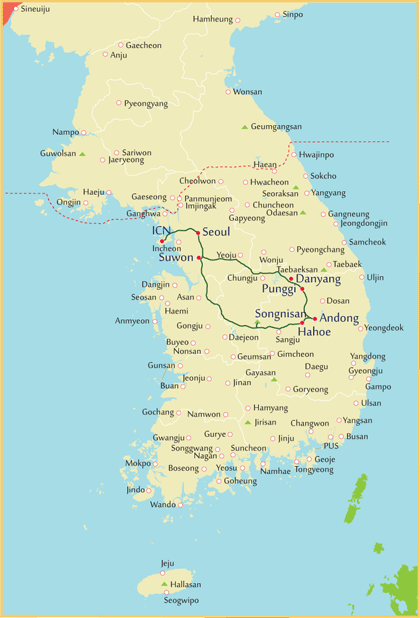 Day 1 Arrive Seoul (- - -)
Day 1 Arrive Seoul (- - -)
60km
Touching down at Incheon International Airport places you in the heart of Korea. After you clear Passport and Customs control, you will be welcomed by the tour guide and then transferred to your hotel.
Day 2 Seoul (B)
Your exploration this morning begins with a driving tour of Seoul, featuring sites such as Seoul Plaza, City Hall, Cheonggye Square and pedestrian-friendly Gwanghwamun Plaza that is hemmed in on three sides by rushing traffic. The plaza is lined on each side with 365m long streamlets, two centimeters deep and one meter across, the stone bed of the plaza's east side waterway engraved with important events in chronological order from 1392 to 2008.
Standing high on a stone pillar is a statue of Yi Sunsin who had engaged in twenty-three naval battles and emerged victorious in all of them during the Hideyoshi invasion (1592-1598). King Sejong who propagated the Korean alphabet in the 15th century is also honored with prominent statue. On August 16, 2014, Pope Francis celebrated Mass in this plaza to beatify 124 Korean martyrs. Near the southwest corner of the plaza is Korea's Kilometer Zero, marking the distances to 64 cities around the world, including Seoul's antipode, Montevideo, Uruguay, 19,606km.
Step back in time to when life was gracefully slow and discover Gyeongbokgung Palace, a particularly charming spot that represents a colorful and turbulent side of the capital's 500-year history. Depending on timing, you may witness the Royal Guard Changing Ceremony featuring parade, password verification, duty shift and patrolling the gate. Accompanied by a court band with its colorful costumes and royal flags, the ceremony is performed daily basis at 10:00 and 14:00 except Tuesdays, although it is cancelled in case of rain or extremely hot or cold weather.
Up from the gates is a spacious stone-paved courtyard that is fully enclosed by wooden cloisters, and at the center of which runs three footpaths through two rows of rank stones, indicating the positions of the officials with the highest rank being closer to the hall.
Standing majestically on top of a two-tiered stone platform that is lined with detailed balustrades is Geunjeongjeon Hall, where the king formally granted audiences to his officials, gave declarations of national importance, presided over large official functions, and greeted foreign envoys and ambassadors. Check out the royal throne and a large painting, depicting sun, moon, five peaks, streams and pine trees, which was the crucial signifier of the king. And up in the center of the ceiling, the bright golden dragons in bold relief indicate the presence of the king.
At the back of the throne hall is a group of court offices. Displayed in front of the King's official quarters is sundial, conceived in order to catch the shadow of the sun, which tells time and 24 periods of seasonal change from the winter solstice to the summer solstice.
Sitting on the island in the rectangular lake is Gyeonghoeru. Supported by 48 square and cylindrical massive stone pillars representing the idea of Yin and Yang, this magnificent pavilion was used for many purposes ranging from receptions to national examinations.
Gangnyeongjeon is the king's sleeping and living quarters while Gyotaejeon is the queen's domain containing a number of halls. The noted feature of these main buildings is an absence of a top roof ridge.
Amisan Garden, landscaped with four hexagonal chimneys in orange bricks, is seldom noticed by the hurried visitors. Jagyeongjeon is the queen dowager's residence. Although less colorful, it is worth noting the wall, adorned with floral designs and the chimneys with ten longevity symbols.
Hyangwonjeong features a small pond with a manmade islet that supports a beautiful two-story pavilion. Behind this serene garden is Geoncheonggung, where the king and queen could relax in peace and quiet. It was here that the first electric lights in the country were installed in 1887 after 8 years of Thomas Edison's invention and a tragic chapter in Korea's history was recorded when empress Myeongseong was assassinated by the sword-bearing Japanese assassins in the early morning of 8 October 1895, allegedly under orders from Miura Goro.
Your visit to the National Folk Museum of Korea will familiarize you with wealthy culture of this friendly and picturesque nation. It is an excellent facility to illustrate the history of traditional life of the Korean people from the prehistoric age to the Joseon dynasty. The permanent exhibition features life and work, costumes and ornaments, handicrafts and technology, educations, living quarters, dietary life, oriental medicine, performing arts and games, beliefs and rituals, and
socio cultural life.
Squeeze in a stop at Jogyesa, is the head temple of Jogyejong the principal sect of Korean Buddhism, emphasizing the Zen orthodox, meditation tradition and the purity of monastic celibacy. The temple does not give off the solemn and traditional air of the other temples located deep in the mountains, but when you enter the temple the frenzy of the city start disappearing. The Main Worship Hall holds triad Buddhas, Sakyamuni, Amitabha and Bhaisajyaraja. The figure in the center is Sakyamuni Buddha who has overcome greed, hatred and delusion. While here it is worth noting the 500 year old lacebark pine and 400 year old locust tree that still grace the property.
Insadong, at one time the center of traditional Korean art and antiques, features a mixture of historical and modern atmosphere representing the cultural glimpse of the nation. Clustered along the main street and alleys are lined with street vendors, wooden tea houses, restaurants and numerous galleries and shops dealing in antiques, oriental art supplies, and modern Korean art of all types and styles. Soak in the paintings, upscale artworks, antiques and potteries while you can. Get lucky and you just might meet the artist themselves. It can be plenty of fun walking on the main street, but you venture into the hidden alleys that do spring some unexpected surprises. While here, you may want to buy some souvenirs or simply wander and browse at leisure admiring cultural ambience.
Drive past Cheonggyecheon Stream. After the Korean War (1950-1953), more people migrated into Seoul to make their living and settled down along the stream in shabby makeshift houses. The accompanying trash and waste, and deteriorating conditions resulted in an eyesore for the city. The stream was covered with layers of concrete in the mid 1950s and roadway until the massive urban renewal project freed it in 2005. Today, a 5.8km creek tumbles gently through downtown Seoul, providing a much needed source of peace and relaxation for the citizens of this fast-paced city. You may have a chance to view the sculpture standing tall at the head of the stream on a small plaza. Created by Dutch artist Coosje Van Bruggen and Swedish artist Claes Oldenburg, a shell rising upward like pagoda symbolizes new life.
You will tour the centuries-old Namdaemun Market brimming with well over 11,000 shops selling anything you can imagine. One of the most colorful aspects of the market is an endless sprawl of street-vendor stalls that setup in the alleys and walkways between the buildings. The market is seriously crowded, so be prepared to get bumped around. A fantastic place to haggle over the price to get the best deal on something you want or simply admire the vibrancy of this massive market.
At the western entrance of the market in the middle of a traffic circle stands Sungnyemun. It is a formidable and iconic construct that served as the southern gate of the wall that surrounded Seoul during the period of the Joseon Dynasty.
Day 3 Seoul - Yeoju - Danyang - Punggi - Andong (B) 290km
Travel to Andong, a stronghold of Confucianism that has deeply influenced the lives of Koreans in all aspects. En route, visit UNESCO World Heritage Site, Yeongneung, a tomb of royal couple of King Sejong who is widely regarded as the most enlightened king in Korean history. He promulgated Korean Alphabet and also invented such scientific devices as a rain gauge, a celestial globe, sundial, armillary sphere, water clock, promoted the development of classical court music, and improved metal type printing techniques. Many replicas of inventions that were commissioned by the king are displayed near the entrance to burial mound. Near the tomb and all around it are life-sized statues of warriors and horses, put here to protect the King.
Danyang is a charming city set in the beautiful surroundings. Here, you will see Dodam Sambong rocks representing the typical love triangle of ancient Korea: a husband, his wife and his mistress. Near the rocks is Gosu cave, known as the most beautiful limestone cave in Korea, formed about 400 million years ago. The cave is filled with intriguing shapes of stalactites and stalagmites formed by large quantity of flowing underground water and the consequent erosions. It is virtually an integrated exhibition hall of all imaginable cave resources.
Next, visit Sosuseowon. It is the first private institute established in Korea, and was a birthplace of Confucian education and a cradle of prominent scholars. It was established by Ju Se-bung in 1543 and named Baekundong Seowon. The compound itself is composed of two sections; academic studies and research, and memorial service. There are several old buildings where scholars learned and studied loyalty, filial piety, manners and knowledge. The institute has a Shrine, which was built to enshrine An Hyang, An Bo, An Chuk and Je Se-bung, where a memorial service takes place twice a year on the first day of the third and ninth months by the lunar calendar.
While in Punggi, a small remote town famous for quality apples and ginseng, you will explore ginseng market with piles of fresh ginseng roots, including variety array of ginseng products. This mysterious root, which has a good smell better than it tastes, has historically been considered an empowering medicine and a cure-all. Street vendors sell flowers, fruits, food stuff and home grown grains and vegetables. With all these features combined creates a rural ambience of Korea's remote town.
Tour also includes Andong Folk Museum offering in-depth information of traditional life and illustrating traditional Confucian culture. The museum exhibits a variety of legacies relating mainly to four cardinal ceremonies, coming of an age, wedding, funeral, ancestral memorial service, as well as dozens of pieces of pottery, utensils, clothing, farming tools and traditional folk games in small models.
Day 4 Andong - Songnisan (B) 140km
Explore UNESCO World Heritage Site, Hahoemaeul from the 15th century. It is the best preserved traditional village portraying and spanning the life of the Joseon Dynasty (1392-1910) and some 480 Korean traditional houses, both large and small, are still fully functioning. As you take a walk in the narrow alleys, enjoy the rustic and old charm of this unique village. You cannot possibly miss a 600-years old zelkova tree, the home to the village spirit. At the tree's base is where residents still make their wishes. The village is also known for traditional festival, Hahoe Mask Dance which gave common people the opportunity to mock those in authority, and in particular the Byeolsingut, a shaman ritual exorcising evil spirits, dating back to the Goryeo dynasty (918-1392).
You will stop off at a traditional paper-making workshop to get a glimpse into the world of hand-made paper manufacturing - a painstaking process which hasn't changed much from ancient times. Start with bark from the mulberry tree, then separate the bark from the fibers that would eventually be transformed into paper. After straining the pulp, adding some glue, drying the paper, and cutting or coloring according to need, they get a quality paper that is unique to Andong.
Your journey continues to Songnisan national park, weaving through the picturesque countryside. En route, make a short stop at a 600-year-old pine tree shaped like an open umbrella. In recent years several branches were damaged by wind and snow, though what remains is still beautiful. Upon entering Beopjusa dating back to 553, you will certainly stand in awe before the enormous golden Buddha gazing down at the temple and a five-story wooden pagoda, the only one left in Korea. Check out a giant iron pot whose diameter is 2.7 meters that may well had been used to feed 3,000 priests in the early 12th century. A stone carved lantern supported by twin lions standing face to face is a rare example of the magnificent Silla sculptures. A stone water cistern is considered unique for beauty and design. Two stone pillars once held the temple banner pole. An excellent carved relief called Maaebul and worship halls also can be seen.
You cannot miss Four Buddhist Instrument Ceremony. The sounds of each instrument, Brahma bell, Dharma drum, wooden fish and cloud-shaped gong, have a function in saving beings of other realms. Hearing them reverberating through the universe, you will reflect upon the profound symbolism of the instruments. It is a great vow to save or enlighten the creatures in the universe including those on land, in the sea, in the air and in hell.
Day 5 Songnisan - Asan - Suwon - Seoul (B) 200km
With leisurely time to pack, continue to Asan to explore Oeammaeul village, one of the traditional clan villages exuding old and rustic charm. The village entrance is marked by stone bridge, pine forest and totem poles. This village with more than 400 years of history has about 70 traditional houses, and is highlighted by 6km-long stonewall paths ringing the village and the amazing artificial water system that goes through the entire village for gardens and agriculture. As you stroll along the pathway, you will see thatched cottages and tile roof houses representing typical village layout of central Korea and at the same time feel the rural ambience and peaceful atmosphere.
While in Suwon, explore UNESCO World Heritage site of Hwaseong Fortress from the 18th century. Though the fortress is relatively small in scale, it is well acknowledged as the best structure of its kind ever built in Korea. A 5.74km-long fortress enclosing both flatland and hilly terrain is parapeted with crenels and merlons and highlighted by four main gates and well over 50 structures including temporary palace where the king sought refuge during war and found rest during times of peace. A walk through the whole fortress could take several hours but it is well worth making a short walking tour to enjoy the splendor of the fortress, including the Korea's largest Janganmun Gate.
Day 6 Departure (B) 60km
After this wonderful trip exploring Korea and with time to reflect on your surprise in your experience, you will return to the airport in time for your flight. By boarding, you are already high above Incheon heading for home.





